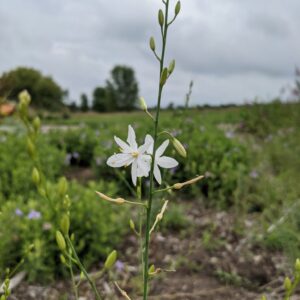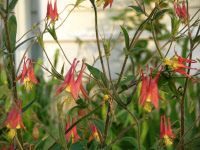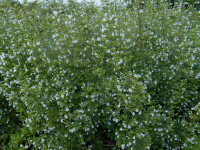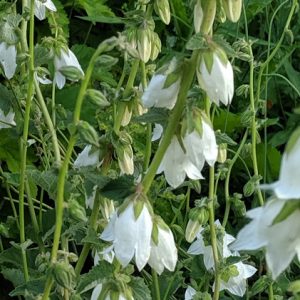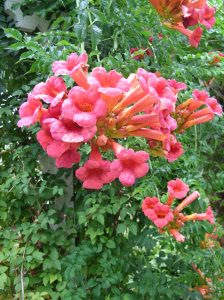Plants for Hummingbirds
Showing 1–8 of 82 results
-
Alcea rosea var. nigra Black hollyhock BIENNIAL Z 4-9
Early to late summer spikes of single jet-black/maroon platters.
Early to late summer spikes of single jet-black/maroon platters.
Size: 5-8’ x 24”
Care: sun in well-drained soil
Native: West Asia
Wildlife Value: Attracts bees, butterflies and birdsHollyhocks have been cultivated in China for thousands of years where it symbolized the passing of time. They cooked the leaves for a vegetable and also ate the buds. Transported from Middle East to Europe by the Crusaders and introduced to England by 1573. Grown in the Eichstätt Garden, the garden of Johann Konrad von Gemmingen, prince bishop of Eichstätt in Bavaria, c. 1600. Culpepper, a 17th century English herbalist, claimed the plant could be used to cure ailments of the “belly, Stone, Reins, Kidneys, Bladder, Coughs, Shortness of Breath, Wheesing, … the King’s Evil,, Kernels, Chin-cough, Wounds, Bruises, Falls. . . (and) Sun-burning.” Both single and double forms grew in England by the time of Parkinson (1629). Parkinson said they came “in many and sundry colours.” John Winthrop Jr. introduced the 1st hollyhock to the New World in the 1630’s.
In the 1880’s Mr. W. Charter of Saffron Walden in England cultivated frilly doubles, now known as ‘Charter’s Doubles.’
-
Anemone multifida Cutleaf anemone, Pacific anemone Z 2-6
Blooming in early summer small six petal-like sepals, watermelon pink, each with a center boss of sunny stamens with deep palmately divided basal leaves underneath.
Blooming in early summer small six petal-like sepals, watermelon pink, each with a center boss of sunny stamens with deep palmately divided basal leaves underneath.
Size: 9” x 6”
Care: part shade in humusy moist well-drained soil
Native: North America except the Arctic
Wildlife Value: hummingbirds build nests from seedheadsCollected by Drummond & Douglas west of the Rocky Mountains Blackfoot Indians called this “Looks-like-a-plume.” The burned seed-head inhaled to stop a headache. British Columbia’s Thompson Indians used this to stop nose-bleeds, calling it “Bleeding Nose Plant.” This red/pink one collected by C.C. Parry before 1860. Parry (1832-1890) tagged as the king of Colorado botany.
-
Anthericum ramosum Spider plant, Branched St Bernard’s-lily Z 5-8
White, branched flower clusters above grass-like leaves June-August
OUT OF STOCK – EMAIL FOR AVAILABILITY
White, branched flower clusters above grass-like leaves June-August
Size: 2-3’ x 12”
Care: full sun in well-drained soil
Native: Western, Central & Southern Europe
Wildlife Value: Attracts bees, butterflies and hummingbirdsPublished by Linneaus in Species Plantarum (1753)
-
Aquilegia canadensis Canada Columbine Z 3-9
May - June scarlet and yellow columbines
May – June, scarlet and yellow columbines
Size: 24-36”x 12”
Care: part shade in moist well-drained soil
Native: Eastern Canada to Florida, west to New Mexico, Wisconsin native.
Wildlife Value: Rich, sugary nectar important food for ruby-throated hummingbirds. Buntings and finches eat the seeds. Sole food source for columbine duskywing caterpillar.Seeds are fragrant when crushed, used by Omaha, Ponca and Pawnee as perfume. Pawnee used the plant as a love charm by rubbing pulverized seeds in palm of hand and endeavoring to shake hand of desired person. Crushed seeds also used to cure fever and headaches. Cherokee made a tea for heart trouble. The Iroquois used the plant to cure poisoning and to detect people who were bewitched. Grown by Englishman Tradescant the Elder in 1632. He may have received it from France. Cultivated by Washington & Jefferson.
-
Bletilla striata syn. B. hyacinthina Chinese ground orchid Z 5-9
Racemes of pinkish-purple flowers on scapes above dark green, upright, lance-shaped leaves, April-May
OUT OF STOCK
Racemes of pinkish-purple flowers on scapes above dark green, upright, lance-shaped leaves, April-May
Size: 12-18” x 12”
Care: Part shade in moist, well-drained soil.
Native: China, Japan
Wildlife Value: Attracts bees, butterflies and hummingbirds. Deer & Rabbit resistant.
Awards: Royal Horticultural Society Award of Garden MeritProtect with thick winter mulch, may not reliably survive Zone 5 winters.
Spreads slowly by rhizomes and seeds in optimal conditions.
‘Bletilla’ honors Louis Blet, a Spanish apothecary in Algeciras who also had a botanic garden at the end of the 18th century. Collected before 1784 by Thunberg. -
Calamintha nepeta ssp. nepeta syn. Clinopodium nepeta ssp. nepeta Lesser calamint Z 4-9
Profuse violet blooms on mint-scented, gray-green foliage gives frosty image, June-October
Profuse violet blooms on mint-scented, gray-green foliage gives frosty image, June-October
Size: 18-24” x 8-12”
Native: Europe and Mediterranean
Wildlife Value: attracts bees, butterflies and hummingbirdsThis subspecies 1st described by Linnaeus in 1753. Genus name comes from Greek kalos meaning beautiful and minthe meaning mint. It is not, however, a mint and is not invasive.
-
Campanula alliariifolia syn. C. gundelia syn. C. kirpicznikovii Ivory Bells Z 3-7
July-August, creamy white bells dangle on spires above heart-leaved foliage. Vigorous. Cut back to promote 2nd flowering
July-August, creamy white bells dangle on spires above heart-leaved foliage. Vigorous. Cut back to promote 2nd flowering
Size: 18-24” x 18
Care: sun to part shade in moist well-drained soil
Native: the Caucasus and Turkey
Wildlife Value: attracts bees, butterflies and birdsCampanula is Latin meaning “little bell.” Described by Carl Ludwig von Willdenow in 1798
Highly touted by Graham Stuart Thomas, who once referred to it as a “picture of poise and beauty,” -
Campsis radicans Trumpet vine Z 5-9
Huge, gorgeous orange trumpets on vigorous vine
OUT OF STOCK
Mid summer into autumn – huge, gorgeous orange trumpets on vigorous vine
Size: 30’ x 3’ at base
Care: sun moist well-drained soil
Native: PA to IL & south as far as Florida
Wildlife Value: Hummingbird magnet.In garden cultivation in America since 1600’s. Collected in 1640’s by English gardener Tradescant the Younger. John Bartram grew it in his Philadelphia nursery nearly 300 years ago. Campsis is derived from the Greek word kampsis referring to the flower’s curved stamens. Radicans from radicant meaning “having rooted stems.” The bloom is “a most splendid sight,” according to Breck in 1851. Per Liberty Hyde Bailey in 1912: “The native trumpet creeper is very common in the southern woodlands and fields (with) a great variety in brilliancy of the blossoms. This is an excellent plant for covering the bare trunks of palmettos.” Pressed specimen in Emily Dickinson’s herbarium.


